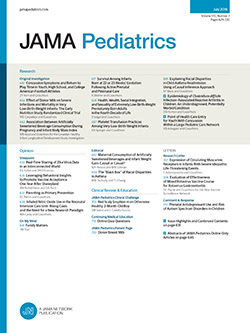Cost-Effectiveness of Treatment for Opioid Use Disorder in Pregnancy and Its Impact on Birth Outcomes.
IF 18
1区 医学
Q1 PEDIATRICS
引用次数: 0
Abstract
Importance For the first time in nearly 2 decades, the US infant mortality rate has increased, coinciding with a rise in overdose-related deaths as a leading cause of pregnancy-associated mortality in some states. Prematurity and low birth weight-often linked to opioid use in pregnancy-are major contributors. Objective To assess the health and economic impact of perinatal opioid use disorder (OUD) treatment on maternal and postpartum health, infant health in the first year of life, and infant long-term health. Design, Setting, and Participants This was a cost-effectiveness, population-based analysis using a stochastic time-to-event discrete-event simulation model to simulate the clinical progression and outcomes for hypothetical pregnant individuals with OUD who initiate treatment during pregnancy. In addition, a scenario analysis was conducted assuming that individuals were stable taking OUD treatment before pregnancy and continued treatment during pregnancy. Data were analyzed from May to September 2024. Exposures Study exposures included outpatient methadone, buprenorphine monotherapy, and buprenorphine-naloxone; outpatient methadone, buprenorphine, and naltrexone after inpatient-managed withdrawal; and inpatient-managed withdrawal with and without an intensive behavioral component. Main Outcomes and Measures Outcomes included return to illicit use; fatal and nonfatal overdose; incremental discounted costs; quality-adjusted life-years (QALYs), which are a combined measure of mortality and morbidity; net health benefit; infant mortality within the first year of life; preterm birth; low birth weight; and neonatal opioid withdrawal syndrome (NOWS). Results In this economic evaluation of a hypothetical cohort of 100 000 pregnant individuals (mean [SD] starting age, 29 [5.6] years), in the pregnancy and postpartum simulation, buprenorphine dominated all strategies, yet methadone was a viable alternative. In the combined infant lifetime model, compared with methadone, buprenorphine showed an incremental effect of 0.262 QALYs per person, totaling 20 960 QALYs for 80 000 Medicaid-affected mother-infant dyads (IQR uncertainty interval [UI] 25th to 75th percentiles, 14 880-27 040 QALYs); mean cost savings of $21 512 per person, totaling $1.72 billion (IQR UI, $1.46-1.98 billion). Compared with naltrexone, buprenorphine showed an incremental effect ranging from 0.228 to 0.229 QALYs per person; 18 240 of 18 320 total QALYs for 80 000 mother-infant dyads (IQR UI, 13 840-22 720 QALYs; naltrexone-oral; IQR UI, 13 760-22 880 QALYs; naltrexone-extended release [XR]). Mean cost savings ranged from $25 316 per person ($2.03 billion; IQR UI, $1.83-$2.21 billion; naltrexone-oral) to $46 437 per person ($3.71 billion; IQR UI, $3.47-$3.96 billion; naltrexone-XR). Conclusions and Relevance Results of this analysis suggest that both methadone and buprenorphine remained viable options for managing OUD during pregnancy and post partum; however, buprenorphine offered the greatest benefits in the lifetime models that account for infant outcomes.妊娠期阿片类药物使用障碍治疗的成本效益及其对分娩结局的影响。
重要性近20年来,美国婴儿死亡率首次上升,与此同时,在一些州,过量用药导致的死亡成为妊娠相关死亡的主要原因。早产和低出生体重(通常与怀孕期间使用阿片类药物有关)是主要原因。目的评价围产期阿片类药物使用障碍(OUD)治疗对孕产妇产后健康、婴儿出生后1年健康和婴儿长期健康的健康和经济影响。设计、环境和参与者这是一项成本-效益、基于人群的分析,使用随机时间-事件离散事件模拟模型来模拟假设怀孕期间开始治疗的OUD患者的临床进展和结果。此外,假设个体在怀孕前稳定服用OUD治疗并在怀孕期间继续治疗,进行情景分析。数据分析时间为2024年5月至9月。暴露研究暴露包括门诊美沙酮、丁丙诺啡单药治疗和丁丙诺啡-纳洛酮;门诊美沙酮、丁丙诺啡和纳曲酮在住院患者管理戒断后;住院病人管理戒断有或没有强烈的行为成分。主要结果和措施结果包括恢复非法使用;致命和非致命过量;增量贴现成本;质量调整生命年(QALYs),是死亡率和发病率的综合衡量标准;净健康效益;1岁以内婴儿死亡率;早产;出生体重过低;和新生儿阿片类戒断综合征(NOWS)。结果对100,000名孕妇(平均[SD]起始年龄29[5.6]岁)的假设队列进行经济评估,在妊娠和产后模拟中,丁丙诺啡占主导地位,但美沙酮是一种可行的替代方案。在联合婴儿寿命模型中,与美沙酮相比,丁丙诺啡表现出每人0.262个QALYs的增量效应,对80 000名受医疗补助影响的母婴双体总计20 960个QALYs (IQR不确定区间[UI] 25至75百分位数,14 880-27 040个QALYs);平均每人节省成本21, 512美元,总计17.2亿美元(IQR UI, 14.6 - 19.8亿美元)。与纳曲酮相比,丁丙诺啡的增量效应范围为0.228 ~ 0.229 QALYs /人;18 320个QALYs中的18 240个(IQR UI, 13 840-22 720个QALYs;纳曲酮口服;IQR UI, 13 760-22 880个QALYs;纳曲酮缓释[XR])。平均成本节约范围从每人25 316美元(20.3亿美元;IQR UI, 18.3 - 22.1亿美元;纳曲酮口服)到每人46 437美元(37.1亿美元;IQR UI, 3.47- 39.6亿美元;纳曲酮- xr)。本分析的结果表明,美沙酮和丁丙诺啡仍然是妊娠和产后处理OUD的可行选择;然而,丁丙诺啡在考虑婴儿结局的终身模型中提供了最大的益处。
本文章由计算机程序翻译,如有差异,请以英文原文为准。
求助全文
约1分钟内获得全文
求助全文
来源期刊

JAMA Pediatrics
PEDIATRICS-
CiteScore
31.60
自引率
1.90%
发文量
357
期刊介绍:
JAMA Pediatrics, the oldest continuously published pediatric journal in the US since 1911, is an international peer-reviewed publication and a part of the JAMA Network. Published weekly online and in 12 issues annually, it garners over 8.4 million article views and downloads yearly. All research articles become freely accessible online after 12 months without any author fees, and through the WHO's HINARI program, the online version is accessible to institutions in developing countries.
With a focus on advancing the health of infants, children, and adolescents, JAMA Pediatrics serves as a platform for discussing crucial issues and policies in child and adolescent health care. Leveraging the latest technology, it ensures timely access to information for its readers worldwide.
 求助内容:
求助内容: 应助结果提醒方式:
应助结果提醒方式:


